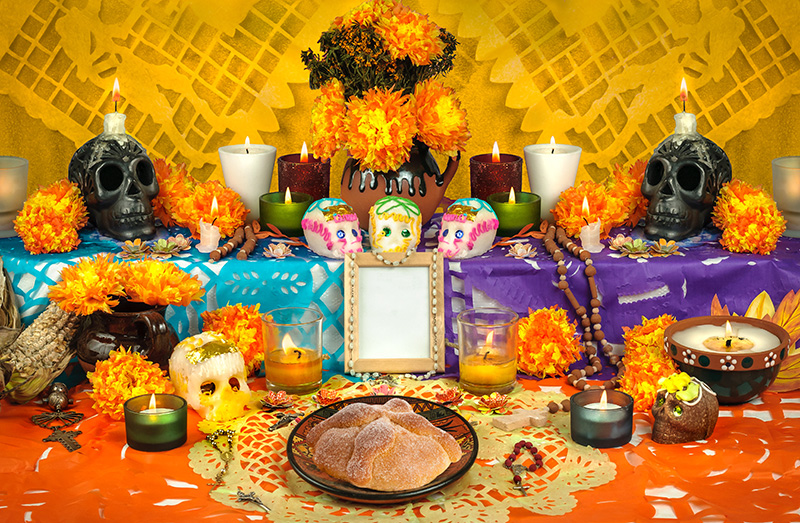
A Day of the Dead altar includes photos, candles, flowers, bread of the dead, rosaries and more. Fr. Ed Anderson, who serves the Rice Lake cluster, observed that sugar skulls, which signify the sweetness of the life cycle, also function as a ‘momento mori,’ the traditional Latin reminder of death. (Getty images)
Jenny Snarski
Catholic Herald Staff
Día de los Muertos, Day of the Dead, with its cultural roots going back 3,000 years to Mexico’s indigenous peoples, is a celebration that can be a bridge toward greater understanding of death as part of the cycle of life and the spiritual richness of the church’s celebrations of All Saints and All Souls Day.
The inculturation of what began as a pagan practice and was converted through Catholic missionaries was moved from late summer, when it was originally celebrated, to coincide with the Catholic feast days on Nov. 1 and 2.
In the Diocese of Superior, Catholics of Mexican origin or Mexican descent continue to honor their dead in traditional ways in early November.
Fr. Ed Anderson, who ministers to a growing population of Hispanic Catholics in the Rice Lake area, has encouraged memorial altars in various parishes.
Speaking of the Mexican tradition, he said that the various indigenous cultures worshipped gods of death out of their belief in life after death.
“When someone died, they were buried with their valuables and other things thought to be needed in the afterlife. God is the God of the living and the dead,” the Rice Lake pastor said. “The church has honored the memory of our dead with great respect, incorporating the traditions of the local culture. Honoring traditions of other cultures and then offering the Eucharistic sacrifice, we are united in the offering of Christ.”
One of the most typical elements of Day of the Dead celebrations are the altars with “ofrendas,” or offerings. Photographs of loved ones are displayed and accompanied by their favorite food or drink and mementos of their life and interests.
Other symbolic items, such as flowers (specifically marigolds), candles and sugar candy skulls, all lend to the festive atmosphere of remembering deceased loved ones.
The sugared skulls are meant to represent the sweetness of the cycle of life, understanding death not as something bitter or to be feared, rather as the hoped-for passage to Heaven. In similar fashion, painting faces as skulls or half living-half skull also symbolizes the transition from life to death.
In Mexico, the Día de los Muertos altars are usually arranged in homes, but during Nov. 1 and 2, even sometimes starting on Oct. 31, items are brought to the cemeteries to decorate and families gather for picnics there to remember, celebrate and pray.
Altars are even set up in public places, such as malls, according to Ana Marquez, assistant for the Office of Hispanic Ministry for the Diocese of Superior.
She added that the Disney Pixar movie “Coco” gives a good general understanding of the altars and ofrendas practices, although is not an accurate portrayal of Catholic theology of death, purgatory and heaven.
Marquez shared how the practice of these days allows for the natural process of grieving lost loved ones as something one doesn’t have to hide but can share with others through remembering and honoring.
In Catholic teaching, burying the dead is considered a corporal work of mercy. Accompanying the grieving and celebrating the memory of loved ones can be seen as extensions of that mercy.
Given that the origins of these Day of the Dead celebrations are not entirely of Christian origin, not every practice is acceptable. However, the practices do highlight the connection among the Body of Christ and the Communion of the Saints uniting the living and the dead.
In light of the secularized environment of Halloween, Día de los Muertos practices can prove to be almost like catechetical tools.
Commenting on the use of skulls and some of the historical Catholic practices, especially used in monasteries and religious orders, Fr. Anderson said, “When we see the words “memento mori,” we may recognize that these Latin words remind us that we must die. The use of skulls is a shocking reminder of death; a disturbing symbol that we need to wake up and live our lives as if this is the last day.”
Quoting the conclusion of Pope Emeritus Benedict XVI’s Angelus address, the priest affirmed, “Those who commit themselves to live like him [Jesus] are freed from the fear of death, no longer showing the sarcastic smile of an enemy but offering the friendly face of a ‘sister,’ as St. Francis wrote in the “’Canticle of Creatures.’”
The pope’s prayer is one that can be repeated, even incorporated into remembrance and Day of the Dead practices:
“Through the intercession of Mary most holy and of St. Joseph, let us pray to the Lord for the grace to prepare serenely to depart from this world, when he wills to call us, with the hope of being able to be with him eternally, in the company of the saints and of our deceased loved ones.”
